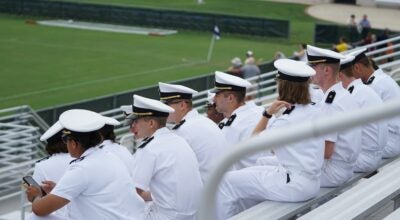UM Celebrates Earth Day with Master Plan Green Spaces
Published 10:30 am Sunday, April 22, 2018
The future of the Ole Miss campus is shaping up to be a walk in the park, according to recent updates of the UM Master Plan.
As part of Green Week at Ole Miss, the university’s Office of Sustainability held a lunch and learn titled “UM Master: Planning for a Pedestrian Friendly Campus.”
The event featured university architect Ian Banner, who is also director of sustainability and facilities planning, as well as parking and transportation director Mike Harris. Banner and Harris shared their thoughts on the UM Master Plan as it relates to transportation and mobility on campus.
Banner focused mainly on the current and future mobility framework at the university, and also explained his office’s reasoning behind the designs.
“What we noticed when looking across the campus is, not much of the University of Mississippi is green, and how we should protect that greenness, in my opinion,” Banner said. “In terms of pedestrianization, green places are the best places to walk because they’re in the shade. They’re very valuable to us, and they’re what has made the spirit of this campus, over the years, so important to us.”
However, the university hasn’t historically been known for its green spaces beyond the Grove and the Circle, Banner said. He went on to show photos of the campus in 1966, with some familiar buildings and one long-gone central parking lot. That lot, of course, became the quad, home of the Phi Mu fountain.
Speaking of that kind of progress, and in keeping with that same theme, Banner discussed plans for a variety of new green spaces he and his team have added to the master plan.
“Jeff McManus (director of landscaping) is planting 1.5 trees a day, which puts him at over 500 trees a year,” Banner said. “Over the last 10 years, that’s over 5,000 trees that we’ve put on campus.”
One space in particular, will be the Faulkner Memorial Garden next to Shoemaker Hall, adjacent to the new Jake Gibbs Belltower. The garden will feature an interpretation of a chimney from the power plant where William Faulkner worked, which was located on the site, as well as spaces for students to socialize and study.
Perhaps the largest new green space will be located where the Tad Smith Coliseum currently stands. According to the master plan, in the next 15 to 20 years, the Tad Pad will be razed tas part of the creation Grove-like space between the Pavilion and the law school building, flanked by new academic buildings and perfect for tailgating on game days. The Tad Pad site itself will become a space reminiscent of the Circle.
Part of expanding the university is renewing a commitment made by former chancellor Dan Jones to become a considerably more pedestrian-friendly campus. Already, this has been done through the creation of an outer ring road. Parking lots are slowly being phased out of the interior and moved to the outskirts of campus, and single-occupancy vehicle traffic is limited to the perimeter, encouraging students, faculty and staff to use public transportation instead.
Harris’s portion of the program centered around the university’s current transportation demand strategy and how his office is working with Banner’s team in its mission to improve transportation for both pedestrians and motorists.
One of the biggest goals, Harris said, is to limit transportation demand or shift it. In order to do that, Harris said the university has implemented two main hubs on opposite sides of campus, where Oxford-University Transit can pick up students, faculty and staff.
According to Harris, implementing the two main hubs makes the bus system more efficient. Another new proposal that will make the busses run more smoothly is reducing the number of single-occupancy vehicles.
“When you start taking those single occupancy vehicles off the road, what you get is a much more efficient bus system,” Harris said. “Those busses aren’t stuck and clogged in that traffic, because now you have the vehicles off the roads.”
Other ways Harris said his office is helping the university manage transportation is through programs such as ZipCars and bike sharing, as well as the elimination of on-street parking thanks to the university’s two parking garages.
More improvements are coming, Harris said, including the edition of handicap-friendly low floor busses, on-bus wifi.
“By combining all these areas, it’s our goal that we have a more efficient and effective transportation system on campus,” Harris said. “Our goal is to change behavior and transportation demand, so we can get in and out of campus in a more efficient way.”





